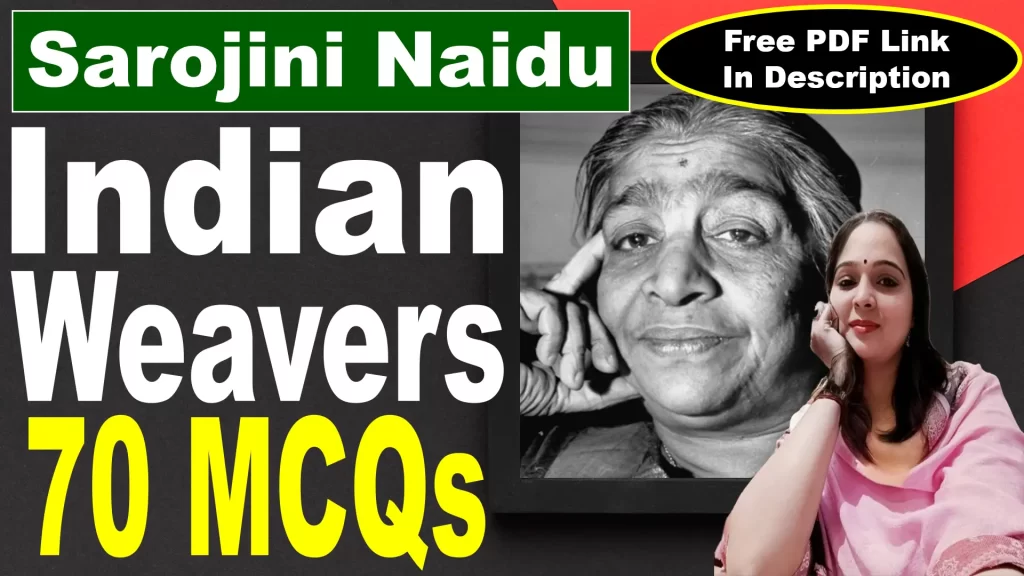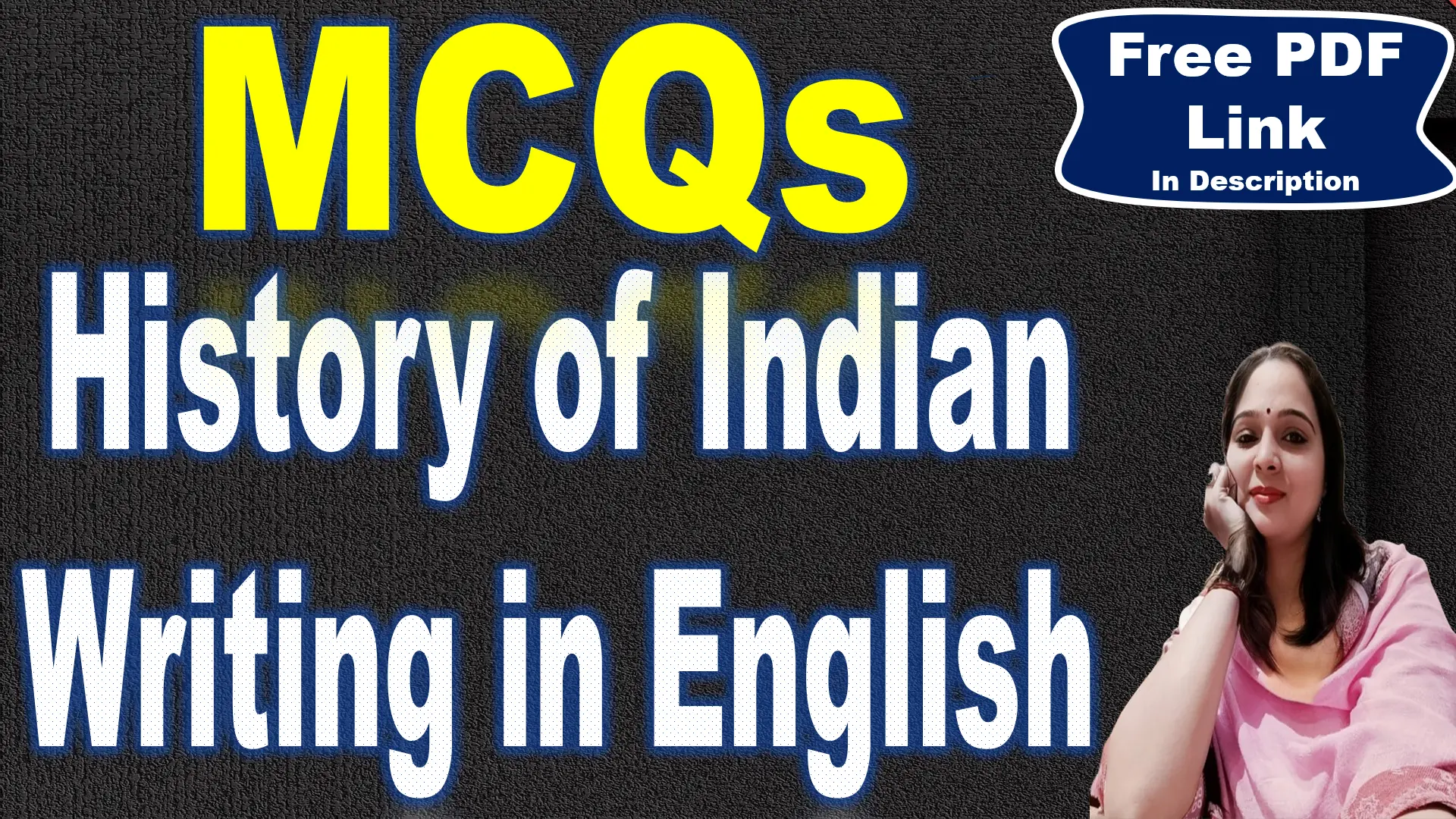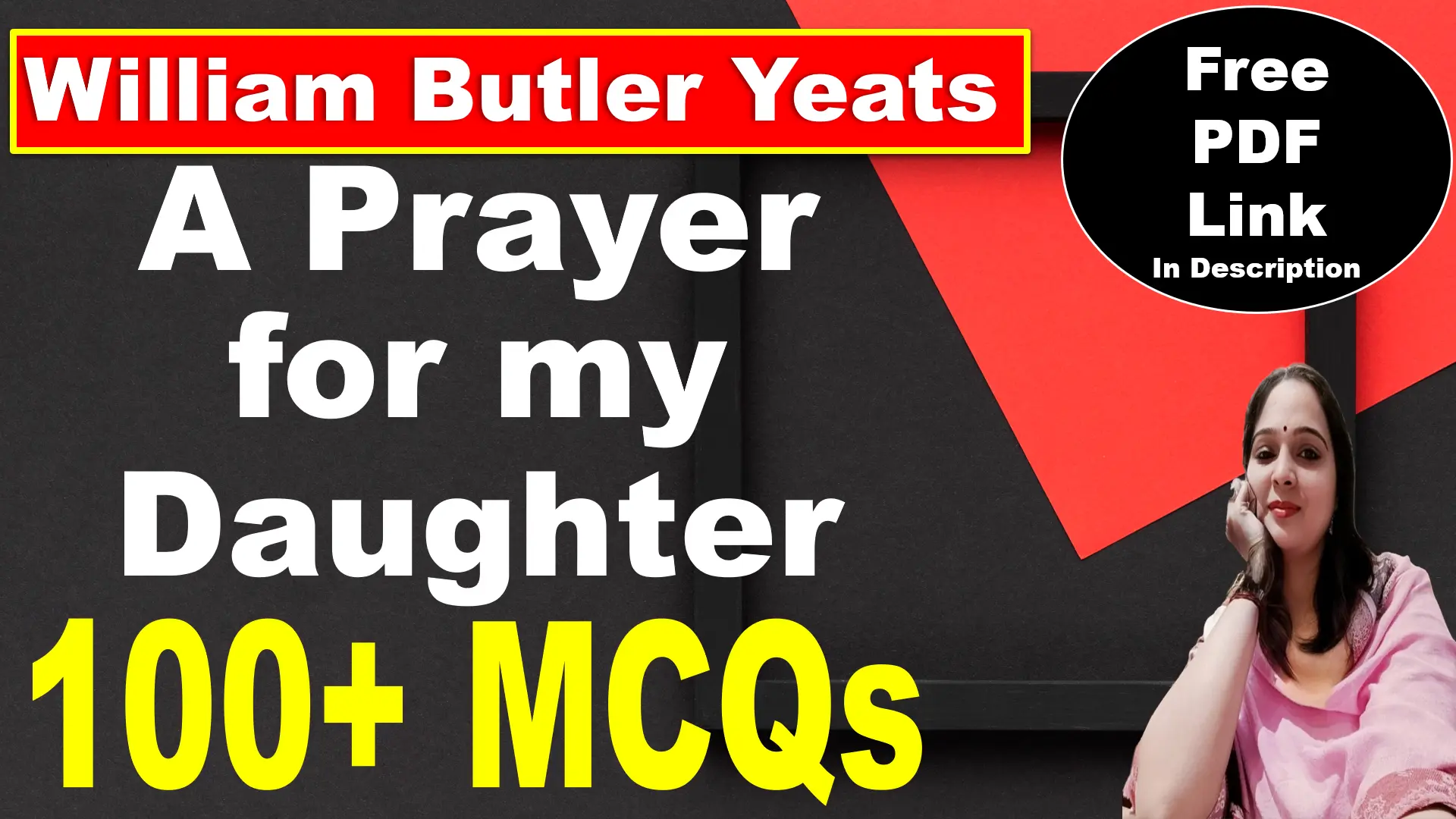
41. The question-and-answer format in each stanza is an example of:
a) Dialogue
b) Apostrophe
c) Caesura
d) Rhyme
Answer: a) Dialogue
Explanation: The question-and-answer format in the poem is an example of dialogue. Dialogue refers to a conversation between two or more people or entities. In this case, the poem uses a structured format where one line asks a question and the next provides an answer. This mimics a conversation between the weaver and the reader, emphasizing the cyclical and reflective nature of the themes being explored, such as life, death, and the human experience.
42. The vivid colors like “purple and green” and “blue” in the poem primarily contribute to:
a) Imagery
b) Metaphor
c) Paradox
d) Synecdoche
Answer: a) Imagery
Explanation: Vivid colors—”blue” (robe), “purple and green” (veil), “white” (shroud)—primarily contribute to imagery, painting strong visual pictures that enhance the poem’s sensory appeal. Blue evokes birth’s calm, purple and green marriage’s vibrancy, and white death’s purity. Metaphor equates without comparison words, not the main effect here. Paradox involves contradiction, absent in colors. Synecdoche uses a part for the whole, not applicable. Naidu’s imagery ties colors to life’s stages, making the garments vivid and memorable.
43. The consistent AABB rhyme scheme (“day/gay,” “night/bright”) is an example of:
a) Couplet
b) Free verse
c) Enjambment
d) Internal rhyme
Answer: a) Couplet (Two consecutive rhyming lines)
Explanation: The AABB rhyme scheme is an example of a couplet. A couplet is a pair of consecutive lines in a poem that rhyme with each other. In the case of “day/gay” and “night/bright,” the lines are paired in a simple, rhythmic pattern that gives the poem a harmonious and structured flow. The couplet form reinforces the theme of life’s continuous cycle and the inevitability of the stages of life, making the poem both accessible and melodic.
44. The line “Blue as the wing of a halcyon wild” describes the color of which garment?
a) The marriage veil
b) The funeral shroud
c) The newborn’s robe
d) A warrior’s cloak
Answer: c) The newborn’s robe
Explanation: The color described here refers to the newborn’s robe. The blue color symbolizes peace, calm, and serenity, which aligns with the themes of birth and innocence. The halcyon bird, often associated with tranquility and peace, further emphasizes the gentle and peaceful nature of a newborn’s arrival into the world.
45. In “Why do you weave a garment so gay?” what does “gay” imply?
a) Sorrowful
b) Bright and cheerful
c) Dull and plain
d) Mysterious
Answer: b) Bright and cheerful
Explanation: In this context, “gay” implies bright and cheerful. The word “gay” was traditionally used to describe something vibrant and full of life. In this line, it refers to the joyful, celebratory nature of the marriage veil, highlighting the happiness and festivity surrounding a wedding. The “gay” garment symbolizes the lively and positive energy of the occasion.
46. The line “Weavers, weaving at fall of night” introduces the weaving of:
a) A newborn’s robe
b) A funeral shroud
c) A marriage veil
d) A ceremonial robe
Answer: c) A marriage veil
Explanation: “Weavers, weaving at fall of night” from the second stanza introduces the weaving of a marriage veil, as confirmed by “We weave the marriage-veils of a queen.” “Fall of night” suggests evening, symbolizing maturity and celebration, apt for marriage.
47. The line “Weavers, weaving solemn and still” suggests what mood?
a) Joyful
b) Playful
c) Sorrowful
d) Hopeful
Answer: c) Sorrowful
Explanation: “Weavers, weaving solemn and still” from the third stanza suggests a sorrowful mood, as it precedes the weaving of a “dead man’s funeral shroud.” “Solemn” implies seriousness, and “still” evokes silence, both tied to death’s gravity at “moonlight chill.”
48. The line “White as a feather and white as a cloud” describes the:
a) Newborn’s robe
b) Marriage veil
c) Funeral shroud
d) Weaver’s attire
Answer: c) Funeral shroud
Explanation: This line describes the funeral shroud. The color white in this context symbolizes purity, peace, and the finality of death. The comparison to a feather and a cloud emphasizes the lightness and softness of the shroud, suggesting a peaceful transition from life to death. The use of white aligns with traditional associations of the color with mourning and the serenity of death.
49. How many stages of life are represented in the poem?
a) Two
b) Three
c) Four
d) Five
Answer: b) Three
Explanation: The poem represents three stages of life: birth, marriage, and death. These stages are symbolized by the garments woven by the weaver—the robe for the newborn, the marriage veil, and the funeral shroud. Each garment corresponds to a significant phase of human existence, highlighting the poem’s meditation on the passage of time and the inevitability of these transitions.
50. What time of day is NOT mentioned in “The Indian Weaver”?
a) Break of day
b) Noon
c) Fall of night
d) Moonlight chill
Answer: b) Noon
Explanation: Noon is the time of day not mentioned in “The Indian Weaver.” The poem refers to the “break of day” (morning), the “fall of night” (evening), and “moonlight chill” (night), but it does not discuss noon. The absence of noon helps emphasize the transitions between significant moments in life—birth, marriage, and death—symbolized by morning, evening, and night.
51. Which color is NOT associated with any garment in the poem?
a) Blue
b) Purple
c) Red
d) White
Answer: c) Red
Explanation: Red is the color not associated with any garment in the poem. The poem mentions blue, purple, and white to describe the garments woven for different stages of life—blue for the newborn’s robe, purple and green for the marriage veil, and white for the funeral shroud. Red, while a significant color in many cultural contexts, is not used in the poem.
52. What does the “halcyon” in the poem refer to?
a) A type of flower
b) A mythical bird
c) A river
d) A cloud
Answer: b) A mythical bird
Explanation: The “halcyon” in the poem refers to a mythical bird. In Greek mythology, the halcyon is associated with peace and calm, often believed to calm the seas during its nesting period. The reference to the halcyon bird in the poem evokes the tranquil, serene quality of a newborn’s robe, symbolizing the purity and innocence of new life.
53. Sarojini Naidu was inspired by which movement in her writing?
a) Romanticism
b) Modernism
c) Realism
d) Surrealism
Answer: a) Romanticism
Explanation: Sarojini Naidu’s writing, including “The Indian Weaver,” was inspired by Romanticism, evident in its lyrical style, nature imagery (halcyon, peacock), and emotional depth, reflecting her English education in the 1890s. Romanticism emphasized emotion, nature, individualism, and the beauty of the natural world. Naidu’s poetry often reflects these themes, as she explored the vivid imagery of nature, the beauty of India, and the deep emotional connections to life’s milestones. Her work also embodies a sense of idealism, particularly in her celebration of Indian culture and the human experience.
54. What is the mood of the first stanza of “The Indian Weaver”?
a) Joyful
b) Melancholic
c) Tense
d) Mysterious
Answer: a) Joyful
Explanation: The mood of the first stanza is joyful. In this stanza, the weaver is described as creating a newborn’s robe at the break of day, a time symbolizing new beginnings. The imagery of a vibrant, colorful garment being woven for a child evokes feelings of hope, innocence, and the promise of a bright future. The use of light and fresh colors further adds to the celebratory and joyful mood.
55. The phrase “plumes of a peacock” refers to:
a) The newborn’s robe
b) The marriage veil
c) The funeral shroud
d) The weaver’s tools
Answer: b) The marriage veil
Explanation: The phrase “plumes of a peacock” refers to the marriage veil. The peacock, with its vibrant and regal feathers, symbolizes beauty, grandeur, and elegance. In the poem, the peacock’s plumes represent the opulence and splendor of a wedding veil, which is associated with the joyous and ceremonial nature of a marriage. The comparison to peacock feathers highlights the rich, colorful nature of the veil.
56. What does the “moonlight chill” in the third stanza suggest?
a) A festive celebration
b) A cold, somber atmosphere
c) A bright and lively scene
d) A romantic evening
Answer: b) A cold, somber atmosphere
Explanation: The “moonlight chill” suggests a cold, somber atmosphere. In the context of the poem, this phrase refers to the creation of the funeral shroud during the night. The coldness and stillness of moonlight symbolize the quietness and solemnity of death. The “chill” enhances the mournful tone, setting the mood for the final stage of life, highlighting the inevitable end of human existence.
57. The poem uses vivid imagery to connect weaving with:
a) War
b) Nature and life
c) Technology
d) Politics
Answer: b) Nature and life
Explanation: The poem uses vivid imagery to connect weaving with nature and life. The weaver’s work of creating garments symbolizes different life stages, such as birth, marriage, and death. The natural world is evoked through references to birds (like the halcyon and peacock) and colors inspired by nature (such as blue and green), emphasizing that life is woven from the same natural forces that shape the environment.
58. Which of these animals is NOT mentioned in the poem?
a) Halcyon
b) Peacock
c) Dove
d) None of the above
Answer: c) Dove
Explanation: The dove is not mentioned in the poem. The poem mentions the halcyon (a mythical bird) and the peacock (whose plumes symbolize the marriage veil), but it does not refer to a dove. The halcyon symbolizes peace and calm, and the peacock symbolizes beauty and elegance, both of which are central to the themes of birth and marriage in the poem.
59. Sarojini Naidu’s nickname “Nightingale of India” reflects her:
a) Political leadership
b) Poetic talent
c) Scientific achievements
d) Military strategy
Answer: b) Poetic talent
Explanation: Sarojini Naidu’s nickname “Nightingale of India” reflects her poetic talent. She was known for the lyrical and melodious quality of her poetry, much like the song of a nightingale. Her poems often celebrated Indian culture, nature, and human emotions, and her ability to evoke strong imagery and emotions through her words earned her this title.
60. What is the rhyme scheme of “The Indian Weaver”?
a) ABAB
b) AABB
c) ABBA
d) ABCB
Answer: b) AABB
Explanation: The rhyme scheme of “The Indian Weaver” is AABB. Each stanza consists of two pairs of rhyming lines. This regular pattern helps create a rhythmic and harmonious flow, reinforcing the themes of continuity and the cyclical nature of life, as the weaver creates garments for different stages of human existence.





